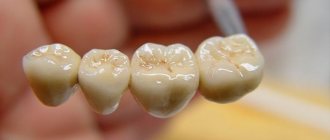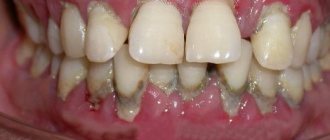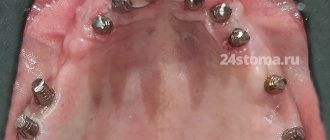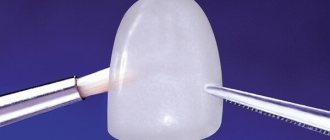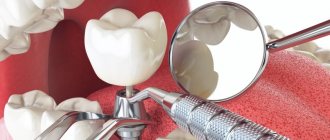A dental crown is a separate type of orthopedic structure used in dentistry to restore the shape, aesthetics and functional functions of a dental unit. Single crowns are used in the process of restoring severely damaged teeth: for example, if due to illness or injury the natural crown has been destroyed by more than fifty percent, it is more correct to restore it not with filling composites, but by installing a dental crown. Dental crowns are also actively used in prosthetics, for the restoration of missing units. Most often, a dental bridge is used for this purpose - a structure in which several dental crowns are connected. The finished prosthesis is fixed in the oral cavity on the supporting teeth, previously prepared to the thickness of the crowns. Bridges are used when there is a defect in a row with the absence of no more than two dental units in a row.
Calculate the cost of treatment by taking a short test in 20 seconds!
Do not delay your treatment, because in this matter time plays against us.
Photos of a single crown and dental bridge will help you get an idea of what the structures look like.
Before restoration with crowns, not only preliminary grinding of the supporting teeth is required: the teeth should be treated for carious damage, restored with a filling, and sometimes endodontic treatment may be required. Professional sanitation of the oral cavity is also recommended. All of the above measures allow restoration with crowns to be carried out with the highest possible quality, without the risk of complications in the future.
When is it indicated to install crowns on teeth?
The main indications for installing dental crowns are as follows:
- Severe destruction of the dental unit, in which the natural crown of the tooth has collapsed by more than fifty percent;
- In case of single defects in the dentition (when no more than two units in a row are missing in a row);
- Aesthetic restoration to achieve an attractive tooth color and shape.
Less commonly, crown prosthetics act as an alternative to orthodontic treatment in situations where it is necessary to change the position of one tooth in a row.
USEFUL TO KNOW: Teeth that are more than 50% damaged due to caries or for other reasons should be restored with a crown, not a filling. Large fillings installed quickly on pins fall out, and in addition, teeth filled under such circumstances usually come out of the bite, which can lead to its failure and disruption of the correct distribution of the chewing load.
An even worse option is that a tooth with a huge filling simply cannot withstand the pressure that occurs when chewing food and breaks, and if a pin is placed, the root of the tooth unit may also be damaged. Trauma to the tooth root suggests only one outcome - tooth extraction.
Prosthetics with crowns has not only indications for implementation, but also contraindications, which are important to exclude before starting the treatment process. Crowns are not installed:
- With mobility of the dental unit;
- Abnormally low height of the natural coronal part of the tooth, leading to the collapse of the orthopedic crown;
- When there are a significant number of teeth in rows.
It will be necessary to postpone restoration with crowns even if the diagnosis reveals an inflammatory process in the upper part of the root system of the tooth or poor-quality filling of its canals.
Under such circumstances, it will be necessary to take measures to eliminate temporary contraindications to crowns and only after that the restoration procedure itself.
Studying price lists
After choosing a clinic, you need to understand how much it costs to insert a tooth, what are the prices per “unit” for a particular method. The cheapest option would be a removable plastic prosthesis, the most expensive would be an implant. If you need to insert a tooth using this method, the price may be quite reasonable, but if you need to insert the teeth completely, then it is better to use the “all on 4” method. In this case, only four implants are installed, onto which the entire jaw structure is attached. This not only makes the procedure cheaper, but also reduces time costs.
If you need to replace several teeth, you can use clasp or bridge structures. They are much cheaper than implants, but they will not protect you completely from loss of bone tissue.
Dental crowns: classification, overview of characteristics and prices for different types of crowns
The classification of dental crowns is carried out according to the material of production. Crowns made of metal alloys of various metals are in maximum demand: they are durable and at the same time have an affordable price for most patients. However, let us make a note - crowns made from alloys of ordinary metals - cobalt, chromium, nickel - will be inexpensive. Crowns made of precious metals are much more expensive and the price of the products will be directly related to their weight.
No less popular types of crowns are structures made of dental ceramics, which include crowns made of zirconium, porcelain, and lithium disilicate. Each type of product has its own unique performance characteristics, which will be useful to learn about in advance, if only because they will have an active influence on the price of the crown.
The cost of a crown per tooth varies from one dentist to another. At the current time, the price of a crown per tooth unit will be:
- Metal-ceramic crown - from 5 to 16 thousand rubles;
- Ceramics - from 16 to 25 thousand rubles;
- Metal crowns - about 5 thousand rubles.
USEFUL TO KNOW: Of course, the price of crowns may seem high, but it is wrong to think that it is so high only because dentists want to profit from patients. The cost of a crown depends on the cost of the material for its production and the complexity of the manufacturing technology. And the production material and technology - the strength of the crown, the timing and comfort of its operation will depend on these factors.
For example, the most inexpensive option is all-metal crowns. However, the aesthetics of such structures are extremely poor; they are practically not used for restorations in the smile area. Therefore, when choosing a crown, you should focus primarily not on the price, but on the result of the restoration you want to achieve. If aesthetics and the durability of the crown are important to you, you should choose crowns made from more expensive materials produced using computer modeling technologies. If the masticatory unit is restored with a crown, you can save money and choose a high-quality and at the same time budget option for the prosthesis.
Below we will consider in detail the features of different types of crowns and find out their approximate cost.
Does it hurt to put teeth in?
It is impossible to say that it is possible to insert ceramic teeth so that the patient does not experience discomfort at any stage. Any prosthesis cannot be made perfectly right away, so it must be adjusted. And if a chewing tooth is inserted incorrectly, it can touch soft tissue when a person chews or even talks. Sometimes even a patient can come and start complaining that after he had a tooth inserted, it hurts. On the one hand, this may seem funny, since an artificial structure cannot hurt on its own. On the other hand, this is a reason to pay attention to the condition of soft tissues, because they are the ones that can hurt and become inflamed. If the prosthesis is made on an inlay, that is, with a real tooth root, then there may be options for the development of periostitis and other inflammatory processes. It is enough for the infection to get into the canal at the root, and the body may not be able to cope with it on its own.
Not only a ceramic tooth can be inserted unsuccessfully, but also a plastic or metal-ceramic one. If possible, the doctor should adjust such a prosthesis on the day of installation so that the patient does not experience pain. The most difficult thing is with removable dentures, as they require long-term correction. Initially, the installation of this orthopedic structure does not cause discomfort, but it may appear later, when the patient has already left the office.
Such dentures rub the gums, so they have to be ground down, and it is not always possible to identify all the problem areas the first time, so that a person feels with the removable structure as with his own teeth. But this is a good way to insert teeth on a limited budget.
Metal-ceramic crowns: features, cost of prosthetics
The basis of this type of crown is a solid metal alloy frame, the average thickness of which is about 0.5 millimeters. From the outside, the metal base is covered with several layers of ceramic mass, which allows you to obtain an aesthetic appearance of the prosthesis, visually indistinguishable from natural teeth. The base can be made from both inexpensive metals and precious metals - gold and platinum.
USEFUL TO KNOW: In terms of price, a platinum crown is only slightly cheaper than a metal-free product, but at the same time its aesthetic indicators are lower, since even the precious metal will shine through the ceramics.
The advantages of metal-ceramic crowns include: reliability and durability, good aesthetics, affordable price (if we are not talking about products made of platinum or gold). The disadvantages of metal-ceramic crowns will be the following: before prosthetics, a significant amount of tissue is removed from the supporting teeth, teeth often need to be depulped first, and the gum tissue around the crown can acquire an unsightly bluish tint. This defect in metal-ceramic crowns is especially noticeable and critical when performing prosthetics in the smile area.
USEFUL TO KNOW: The defect of cyanosis of the gums occurs due to contact of the crown with soft tissues. To avoid the occurrence of such an unpleasant phenomenon, you can order in advance the production of a prosthesis with a shoulder mass, in which the lower part of the base of the product is also covered with a layer of ceramics. Prostheses with shoulder mass have a more complex production technology, and therefore their price is higher than for conventional crowns.
Having understood the features, advantages, and disadvantages of metal-ceramic crowns, we can move on to considering their cost. On average, a crown of this type, made of high-quality alloy, will cost about 8,000 rubles. If expensive ceramic materials are used for veneering the crown, allowing for high aesthetics of the product, the price of the crown will be higher and can amount to 10 thousand rubles.
The price of crowns with shoulder mass will be even higher - from fourteen thousand. Prices for metal-ceramic crowns may be lower - 5-6 thousand rubles, but usually at this price they offer products in the production of which domestically produced materials were used. Let’s be honest, the domestic product does not meet European quality standards, and therefore the finished crowns will not be distinguished by high levels of aesthetics and reliability.
Crowns with a base of gold or platinum cost about 10 thousand rubles. But the indicated amount is the cost of manufacturing the prosthesis, to which should be added the price of the precious metal per gram of weight. As a result, the price of the crown is already a different amount - from 18 thousand rubles.
It is important to note: the price of crowns does not include pre-treatment services and the cost of a temporary prosthesis.
Ceramic (metal-free) crowns: overview of types, performance properties and prices
The main difference between such crowns and metal-ceramic analogues is that they are produced without a cast metal alloy frame and this gives two advantages at once: high aesthetics and the possibility of using crowns in patients with allergies to metals. The aesthetic and most natural appearance is ensured by the translucency of the ceramic; according to this property, the material will be almost identical to natural tooth enamel.
USEFUL TO KNOW: Opaque ceramic masses are used for veneering metal-ceramic crowns, and therefore the finished crown will look somewhat unnatural.
Ceramic crowns can be made from zirconium dioxide or E.max glass ceramics. Both crown materials have high levels of transparency and therefore products made from them will look natural and visually indistinguishable from natural teeth.
Zirconium crowns
An innovative CAD/CAM manufacturing technique is used to produce zirconium dioxide crowns. It allows the production of orthopedic structures with minimal human intervention. Crowns are turned using milling equipment, and their layout is made using special computer technologies.
Zirconium is a unique material; it not only has optimal biocompatibility with the human body, but also high strength, comparable to the strength of metal. The cost of zirconium crowns starts from 16 thousand rubles.
Two types of zirconium crowns can be used for restoration and prosthetics:
- Two-layer, that is, consisting of a zirconium frame, which is subsequently covered with ceramic mass. The use of this type of crown allows you to obtain the most aesthetic result of restoration, but there is also a minus - if used incorrectly, the ceramics from the frame may chip and the prosthesis will have to be restored;
- Monolithic crowns are machined from solid zirconium blocks and do not have a porcelain outer layer, but in terms of aesthetics they will be significantly inferior to the first type of product.
If prosthetics are performed in the area of the front teeth, where aesthetics are important, glass-ceramic crowns may be the best choice.
How is an implant inserted?
The essence of this technique is to implant a titanium root into the jaw, on which a crown is subsequently installed. On average, implant healing takes from 2 to 6 months. During this time, a temporary orthopedic structure is installed for the patient’s convenience.
There are protocols for immediate implantation. Modern structures can be inserted after tooth extraction and immediately loaded with a prosthesis. Many patients are interested in whether it is painful to insert a dental implant. In fact, implants are installed quite quickly (15 - 20 minutes per tooth), and an injection of anesthesia allows you not to feel pain. If you have severe dental phobia, the doctor will suggest inserting teeth under anesthesia or sedation.
Glass-ceramic crowns E-max
Glass-ceramic crowns are an excellent option for those who want to get the most aesthetic results from prosthetics. The cost of one E-max crown is from twenty thousand rubles.
Despite all the advantages, glass-ceramic crowns have one significant disadvantage: they are applicable only in the case of single defects in the dentition. A bridge can also be made from glass-ceramics, but with no more than three crowns, and it is fixed in the area of the front teeth. These limitations are associated with the strength of glass ceramics, which will be insufficient for a massive bridge, which will also be subject to significant load (during the restoration of chewing units).
Single glass-ceramic crowns can be used for prosthetics of any teeth - front and chewing. Such crowns can be monolithic or two-layer; any type of product is produced using computer modeling technology.
Features of the method
All-on-4 is a technology of simultaneous implantation and dental prosthetics, when the patient is implanted with only 4 implants, on which a conditionally removable denture is fixed. Fastening the prosthesis with screws allows the dentist to quickly and easily remove it (this may be necessary, for example, for its correction).
Indications:
- Complete absence of teeth on one or both jaws.
- Bone atrophy.
- Contraindications to traditional two-stage technology.
- Periodontal diseases.
- The previously installed bridge and crowns are worn out
Restrictions and contraindications:
- Malignant neoplasms.
- Diabetes.
- Kidney, liver and heart failure.
- Blood diseases.
- Extreme bone atrophy in the upper jaw.
- Temporary restrictions: inflammatory diseases of the nasal sinuses and infections of the oral cavity.
Cast crowns
The main material for the production of cast crowns is an inexpensive alloy of cobalt and chromium; their surface looks perfectly smooth and even, like well-processed and polished metal. If desired, you can do a finishing gold plating. Cast crowns have good durability and wear resistance, a budget price, but extremely low aesthetics. The average cost of a cast crown is five thousand rubles.
Cast crown products are a good option for prosthetics in the area of chewing teeth; they do not require significant grinding of the teeth that support the fixation of the prosthesis. If such crowns are placed in the smile area, they can be additionally lined with special plastic overlays to achieve greater aesthetics.
Stamped crowns
In modern dentistry they are used extremely rarely, since they have few advantages, but a significant number of disadvantages. Stamped crowns are produced from a special type of blank - metal sleeves. Such a crown can be made with gold or silver plating.
As mentioned above, crowns using the stamping method were valued for their low price and the absence of the need to sharply grind the supporting teeth, but stamped crowns do not have an aesthetic appearance, quickly deform, and do not fit tightly to the neck of the tooth, which is why residues can get under the crown food, saliva and, naturally, pathogenic microflora. Caries under stamped crowns was not uncommon!
Gold crowns
Gold crowns are not installed in every dentistry - working with precious metals requires a special license, which is quite difficult to obtain. Moreover, the cost of a finished gold crown is equal to the price of a more aesthetic ceramic crown, so it is unlikely that you will be able to save money on installing gold dentures.
The price of a gold crown will be calculated as follows: the price of the precious metal in grams is added to the cost of manufacturing the prosthesis. The total amount of precious metal that goes into the production of the crown is taken into account. How much metal is required is a difficult question to answer; it all depends on the tooth, its position in the row, and the anatomical features of the structure.
Metal-plastic crowns
Another name for this type of crowns is combined. The structural structure of the crowns is as follows: a cast metal alloy frame, which is additionally covered with a white plastic mass. The advantage of combined crowns is an affordable price, as well as acceptable aesthetics. The average cost of metal-plastic crowns starts from five thousand rubles.
However, combined crowns have a number of disadvantages that are definitely worth considering:
- The plastic finish of crowns very quickly loses its visual appeal; it may turn gray or yellow. Plastic tends to absorb moisture from the external environment and therefore the plastic layer swells and an unpleasant aroma begins to emanate from it;
- Combined crowns do not have high strength indicators; they can break due to excessive loads; most often, during the chewing process, it is the finishing plastic lining that falls off.
Plastic has fairly low biocompatibility rates, so metal-plastic crowns are not recommended for installation by people prone to allergic reactions.
Combined dental bridges with crowns made of different materials
Bridges for crowns made of metal-ceramics and crowns made of metal are made on the same base - on a frame cast from a metal alloy, and therefore crowns from different materials can be combined on a bridge of this type. For example, crowns that fall into the smile zone can be made from more aesthetic metal-ceramics, while crowns that are invisible to others can be made from metal.
The work on manufacturing a combined bridge will not be highly complex, but the overall cost of prosthetics with crowns will decrease, which is not always adequately perceived by doctors seeking to make money on their patients. If you are assured that a combined bridge with crowns cannot be made in your case, you are being deceived and it probably makes sense to go to another dentistry, where the patient’s wishes are perceived and taken into account.
Medium complexity implantation Impro
In more complex cases, such as single-stage implantation (in one operation the patient’s tooth is removed and an implant is immediately installed in its place), we use German Impro implants. This is a more responsible procedure, it costs more, about 30,000 rubles. The increased cost is associated with the fairly high complexity of this manipulation.
Only a doctor with very extensive experience can perform immediate implantation. For such an operation, it is very important to remove the tooth correctly - the removal should be as gentle as possible in order to preserve bone tissue for subsequent implantation. Sometimes tooth extraction takes 30-40 minutes, and the implantation itself takes only 5-10 minutes. Successful simultaneous implantation requires both high qualifications of the doctor and the use of special devices.
In addition, this operation is often accompanied by additional procedures (soft tissue plastic surgery, bone plastic surgery, etc.), the cost of which is also included in the total price for one-stage Impro implantation.
This is interesting: Impro implantation surgery in 7 minutes:
Crowns on implants
The price of implant crowns will largely depend on the material used to make the crown and abutment. Typically the following options are selected:
- Metal-ceramic crown + titanium abutment. The price of a crown will be 15 thousand rubles per tooth;
- Zirconium crown and zirconium abutment. The price of a crown starts from 25 thousand rubles.
Of course, prices for crowns on implants are higher, but the high cost in this type of prosthetics is due to the more complex process of making crowns.
Calculate the cost of treatment by taking a short test in 20 seconds!
Do not delay your treatment, because in this matter time plays against us.
Is it possible to insert teeth without grinding down the adjacent ones?
Before installing classic dentures with fixation on natural teeth, preparation is required. Without grinding, restorative procedures are carried out using plastic structures with special clasp hooks that clasp the neck of a healthy tooth and thus hold the prosthesis in the oral cavity. The production and installation of such prostheses occurs much faster than in the case of overlay prostheses on implants, but you should not count on recovery in one day. If we are not talking about temporary prostheses, the creation of structures, fittings, and corrections can take several weeks.
Factors in determining the price of prosthetic crowns
Even for crowns made from the same material, produced using the same technology, prices in different dentistry can vary greatly. This is explained by the fact that when determining the price of a crown, the following factors are taken into account: The pricing policy of a particular clinic. Different dentists focus on different consumer audiences. Therefore, prices may vary. For example, in some dentistry, the price of zirconium crowns will be 25,000 rubles, but you can also find offers with a lower cost - from fifteen thousand rubles; Experience, level of qualification of the doctor who will conduct orthopedic treatment; The work of a dental technician directly involved in the manufacture of crowns. The crown production technology can also be mentioned here; Cost of crown production material; Equipment of the medical facility. If the clinic does not have its own laboratory for the production of dentures and crowns, it will be forced to turn to the services of a third-party organization and, naturally, will include its costs in the price of the crown.
Equipment of the medical facility. If the clinic does not have its own laboratory for the production of dentures and crowns, it will be forced to turn to the services of a third-party organization and, naturally, will include its costs in the price of the crown.
Of course, any person faced with the need to get a crown wants to save on the service and at the same time receive high-quality treatment. It is possible to save on prosthetics with crowns, but the approach to saving must be competent. For example, you can install a combined bridge with crowns made of different materials or opt for metal crowns if we are talking about prosthetic teeth while talking and smiling that remain invisible to others.
But we categorically do not recommend you to chase low prices for dental crowns. Most often, the low price of crowns is not explained by a profitable promotion from the clinic, but by the low quality of materials and the work of inexperienced doctors and technicians. Such a crown will not last long, which means you will have new visits to the dentist and, accordingly, new expenses.
Would you like to receive detailed advice on crown prosthetics? Make an appointment with our dental specialists in Moscow - Vanstom!
Five important questions about how to insert teeth
Before describing technologies for restoring lost teeth, we will briefly answer the most popular questions that interest almost all patients who are faced with the need for prosthetics for the first time.
- Do I need to replace teeth if I have lost them?
Dentists recommend doing this immediately and without fail. Even if the emptiness in the dentition is unnoticeable, do not delay your visit to the clinic. Lack of timely treatment leads to resorption of bone tissue, displacement of the dentition, deterioration of the bite, and can cause changes in the shape of the face and problems with the digestive system. - What teeth can be inserted?
Absolutely everything: natural incisors, canines, molars and premolars can be successfully replaced with dentures. - Does it hurt to put teeth in?
Many patients familiar with the methods of Soviet dentistry are concerned about the question of whether it hurts to insert teeth? We hasten to reassure you: modern methods of anesthesia make the treatment absolutely painless. - How long does it take to insert teeth?
It all depends on the treatment method, the efficiency of the doctors and the dental laboratory. Temporary teeth can be inserted in one visit; permanent dentures require more time. - What is the name of the doctor who inserts teeth?
The doctor who inserts teeth and performs prosthetics is an orthopedic dentist, but treatment and preparation for procedures is usually carried out by a whole team of specialists: dental surgeons, dental therapists, dental technicians.

